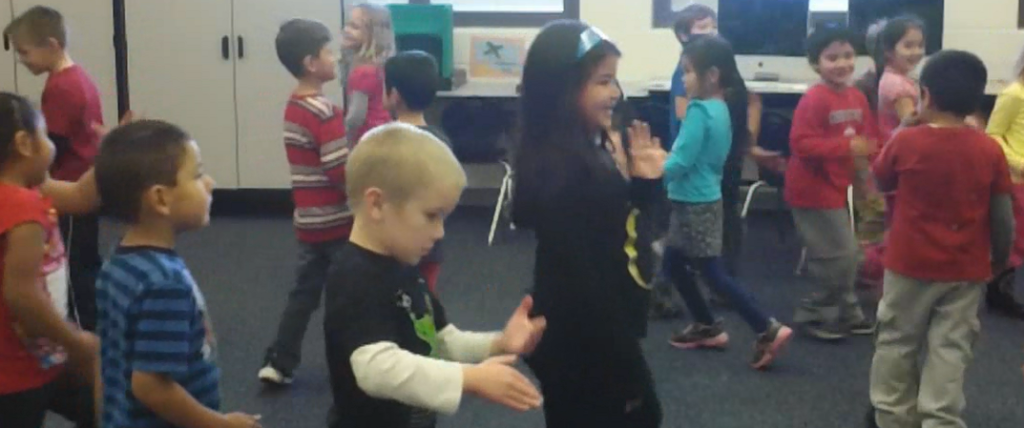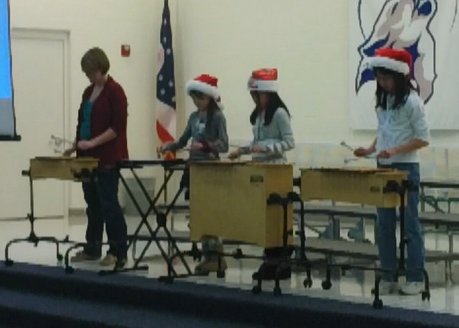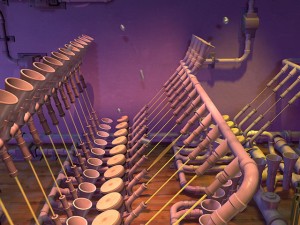


At my school we have half-day kindergarten classes, and these students do not typically attend music, art, or PE class. Some kindergartners who need extra help with reading or with English language acquisition stay for an additional half-day of intervention in these areas. These students get 25 minutes of the special area classes every third day. This is technically a "duty" for the special area teachers because we do not assess these students, but we try to provide meaningful experiences for the kids in that short amount of time.
One of the favorite activities for the kindergartners on music days is dancing. We do lots of different creative movement activities with different selections and genres. Each song is known by its dance; for instance, Dance of the Sugar Plum Fairy is "the tiptoe song." To give the kids the choice of which songs they want to do, I used to have them just tell me, but then I got SMART (pun intended). I created a SMART Notebook file with an icon for each of our songs that links to the song on Spotify. When it is a child's turn to choose the dance, he or she simply comes up to the SMART Board and taps on the icon that represents their song choice. With Spotify open on the computer, the music starts automatically.
Below is a video of my kindergarten students choosing and dancing to their song selections. Since filming this, I have changed how I use my SMART Board. Instead of having the same image on the computer screen and SMART Board screen, I use the SMART Board as an extension of the computer desktop. This allows me to keep the internet browser and Spotify window open on the desktop, but only the SMART Notebook file shows on the SMART Board. Much better!
[vimeo=58586858]
You can download the SMART Notebook file here. I have included circles covering the different icons. I found that it works best for me to limit the number of choices at first and to reveal and learn new dances every couple of weeks. I simply delete the circle that had covered the newly learned song and re-save the file for next time. Spotify can be downloaded here. If you can't get Spotify on your school computer, below is the list of songs I use on the SMART Notebook file. You can always attach mp3 files of the songs to the file instead.

Every year my school has a Holiday Sing-Along on the last day before winter break. All of the students gather in the gym for about 30 minutes to sing together and have fun while the room parents set up the classrooms for the winter parties. I created a PowerPoint presentation that includes the song lyrics, accompaniments, and usually a couple of fun videos to break things up a bit. I also like to feature some student performances during the Sing-Along, such as the Nutcracker dances we choreographed during music classes. This year, I had three very talented fifth grade ladies who completed the entire recorder book, and I really wanted to give them something special to perform.
I discovered that the music for Carol of the Bells is in the public domain (woo hoo!), so I decided to arrange it for the instruments I had. I have some nice Sonor Orff instruments, but they are all diatonic (C major with F-sharp and B-flat additions). Luckily my husband is an instrument hoarder, and we also own a chromatic glockenspiel that I was able to use. I downloaded the MIDI from cipoo.net and imported that into Sibelius 6. After tweaking the instrument ranges and the key, I had a recognizable arrangement that I am very happy with and my students enjoyed learning.
Below is the video of my students' performance at the Sing-Along. We rehearsed during the girls' recess time approximately three days a week for three weeks. I let them choose which parts they wanted to play, and of course, they gave me the easiest part. After a few rehearsals I realized that they had memorized their parts, so I asked if they wanted to perform from memory (they did), which meant I had to memorize my part too (good thing I had the easy part). The instruments on the video from left to right are: Mrs. Riley on diatonic soprano xylophone, Reina on chromatic glockenspiel, Noyuri on diatonic bass xylophone, and Yuna on diatonic alto xylophone. We found that we were able to best stay together in the echo-y gym with the melody and bass parts in the center of the stage.
[vimeo=56510707]
Because I am running Sibelius 6 on a Windows machine, creating a PDF version of the sheet music was not native. I found a great tip on how to easily create PDFs from Sibelius at Sibeliusblog.com. The recommended PDFCreator took about 5 minutes to download and install. All I had to do was choose it from the print dialog in Sibelius. Yay!
Download the full score and parts in PDF format as a zip file here.
The photos below are of my classroom. Click on them to enlarge and read details about each one. After scrolling through, at the bottom of the page are some downloads and links to things from my classroom in which you might be interested. If you have any questions about anything, please let me know in the comments. I'm always happy to share my resources!
[gallery link="file" ids="1082,1077,1081,1074,1071,1067,1075,1076,1078,1068,1069,1080,1070,1072,1066"]
Classroom rug (Joy Carpets Note Worthy© 10' 9" x 13' 2" Area Rug), funded by my PTO.
Hilliard City Schools K-6 Music Scope and Sequence curriculum map download.
Music Class Rules and Consequences downloads.
Rules of Good Singing Icons download.
Cubby Labels download.
Boomwhacker storage idea from Pinterest.
Picture Book Storage (Bird In Hand Greenguard Certified Five Shelf Book Display Stand - 36 x 12 x 29 inches - Birch).
 (Image from Animusic.com)[/caption]
(Image from Animusic.com)[/caption]One of the most requested DVDs in my classroom is Animusic. If you are not familiar with the Animusic DVDs (there are currently two, with a third in development), you MUST check them out. The DVDs feature musical compositions and computer animations in which theoretical instruments play themselves. It is a very cool visualization of music making that easily grabs kids' attention and imaginations. Animusic even has teacher guides for their two DVDs available on their website.
One of my personal favorite pieces is called "Pipe Dream" and the awesome folks at Animusic, LLC have uploaded it to YouTube for your viewing pleasure.
It turns out, my students and I are not the only ones who love "Pipe Dream." Some really smart people at Intel created a real life "Pipe Dream" that you can watch in the video below and compare to the original animated version.
Mind = Blown.
Every so often, I get great emails from other music teachers. Usually, I'm really good about replying right away, but lately, I have been slacking in that department. Below are some of questions I have received, with my replies.
~Kelly
Q: What technology do you have in your room? It sounds like your kids do computer-based listening and projects right in your room. Do your computers have headphones?
A: I have a SMART Board on a height adjustable wall mount with integrated projector at the front of my classroom. This is connected to the desktop Mac computer on my desk. My stereo system is also connected to that computer so when I show video on the SMART Board or use Spotify to play music, it plays through the good stereo speakers mounted on the wall. I have a 5-disc CD changer, that I rarely use anymore, with Spotify on the computer. There are also 4 other Mac desktops in the room. All of these computers have SMART Notebook installed as well as the iLife suite which includes GarageBand. If I need a whole class to be using computers, I will check out a laptop cart and bring it to the music room. Just this year, my school went wireless, so the only thing I have to plug in is the power to charge the computers in the cart. My school has another SMART Board like mine in our computer lab. If we are doing a project that requires a lot of printing (like this one), I will check out the computer lab and take my whole class there for their music time.
A couple of years ago, I used some of my very generous PTO funds to purchase an Aleratec RoboRacer Stand Alone CD/DVD Duplicator. This has been a very worthwhile investment! I do a fifth grade CD release project every year, and we give away/sell more than 100 CDs each year. I remember the days of running between the 5 desktop computers in the room trying to get enough CDs burned, and am ever-so-thankful that I have this machine now. I have also purchased some Blue Microphones for our CD recording project that have come in really handy. The USB interface is so easy, and the sound quality is phenomenal.
I only have the kids use headphones with the computers when they are using GarageBand to compose, record, and edit their own songs. When it comes to online music games, as long as no single computer's volume is turned all the way up, everyone can hear their own machine just fine without headphones. I am planning on using my PTO funds this year to upgrade and expand my headphone collection. When my building opened six years ago, each grade level classroom had a listening center outfitted with Califone Switchable Stereo/Mono Headphones for their listening centers. When I needed more headphones for the GarageBand projects, I commandeered some of these from teachers who weren't using all of theirs, and my students fight over who gets these "good" headphones rather than the cheap ones I have. I will definitely be purchasing more of these this year. I also have quite a few headphone splitters so my students could work on their projects in pairs. However, this year we have added a third section of fifth grade, considerably more GarageBand projects for me to listen to and edit than ever before. So, I decided in order to keep myself sane, I will have the kids work in groups of three, requiring me to purchase new splitters that allow more kids to listen at one computer. I'm leaning toward this Belkin model, but I haven't comparison shopped yet, so that decision is subject to change.
Q: I was hoping to also see what kind of musicals and music programs you do but could not find links on your page. Could you write back about what you do for your evening programs, too?
A: I am lucky to be married to a talented composer and musician. My husband, Justin has written a few really great musicals for my kids over the years: A Timeline of Ohio, Funny Pet Shop, and The Old Man and the Sparrow. A couple of years ago, I gave him some time off and purchased a cute little set of musicals from Music in Motion. My second graders performed Tikki Tikki Tembo that year. I also had an amazing group of fifth graders that year, so I wanted to send them off with a bang. They performed Schoolhouse Rock Live! Jr. that year.
My contract does not require me to do any evening performances with my students, and in years when I have been in grad school, I have found other ways to get parents involved in music classes with their students. Last year, the art and PE teachers worked with me to create a great new (and soon-to-be annual) event at my school that we called "Bring Someone Special to Specials Day." During this one-day event, adults could come to school during their student's special area class time. We rotated all of the students in grades 1-5 through all three specials classes during their 50 minute time slot. During the art time, they participated in an scavenger hunt looking at the student art in the halls; during PE, they played jailbreak (similar to what I called "dodgeball" as a child); and in music, we did different folk dances and singing games. The turnout was HUGE, and everyone had a blast! (And no evening commitment for me!) It was so successful that our library/media specialist has asked to be in on the action this year, and our second annual event is already on the calendar for this April.
Q: What textbook series do you have, and do you use it much? Your website makes it sound like everything you do is technology-based; I don't see any references to singing.
A: I do not have a textbook series, nor did I use one when I did have it. My pedagogy is based on the Kodály philosophy of music education, and my students sing tons of folk songs and learn most of their music reading concepts through this literature. In fact, in grades 1-4 we do more singing than anything else. Fifth graders get away from singing to do more hands-on activities like continuing their recorder playing from fourth grade and working on their GarageBand projects on the computers. Most of the time, I use my SMART Board in much the same way that I would use a regular chalkboard or whiteboard, just in a more interactive format. You can download some examples of my SMART Board files here. I recently uploaded a couple of files that are more typical of my day-to-day Kodály-based instruction: Ta Ti-Ti Preparation and Ta Ti-Ti Presentation.
Q: My principal told us (me and my other elementary music colleague) that we are going to have to come up with common assessments for elementary music. I went to a couple sessions at OMEA on the new standards coming and merit pay stuff. When I asked the clinician if ODE was going to publish music assessments like they have done for PE, he said not to his knowledge. I have contacted an OMEA board member to see if there are any districts who have already done common assessments for music so that we don't have to start from scratch, and he didn't know of any. We are a RTTT district and HAVE to do them. Can you be of any assistance? I know Hilliard has a great music deptartment. Do you already have a common assessment framework started or can you direct me to someone from another district who has?
A: The Hilliard City School District is also a Race to the Top (RTTT) district, and as an elementary music department (which is great, and I love being a part of it!), we have been talking about common assessments for the past year or so. However, because the state has yet to release all of the details of what these assessments need to be, we have not actually started the process of creating them. The district plans to begin that process after winter break and will likely continue into early summer. Fortunately, we have just revised and adopted a new K-6 Performing Arts Course of Study, so the 2012 Ohio Music Standards are fresh in our minds. With the help of my colleagues on the course of study revision committee, I synthesized the Ohio Standards to create this easy-to-read chart, organized around the nine National Standards for Music Education. Content statements indicated with an asterisk (*) are Hilliard specific statements that we felt were important as we were revising our old course of study.
Q: I was wondering if you would ever post examples of your bulletin boards or how your classroom is set up?
A: I am planning to write a whole post with photos of my classroom and bulletin boards, so check back soon!